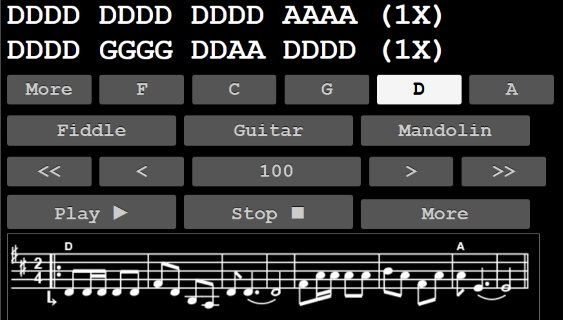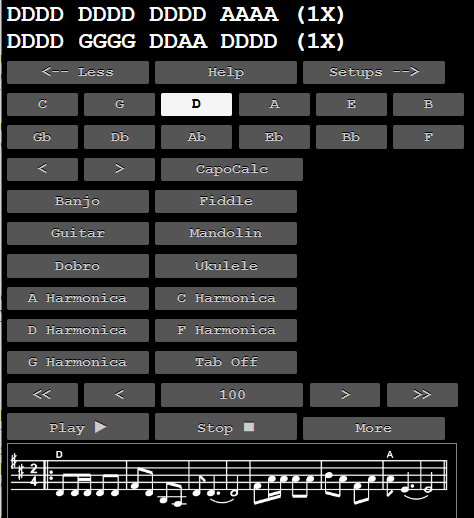Many musicians don't read music. They learned to play their instruments by ear and have learned songs by ear. My favorite characterization is "If they can whistle it, they can play it."
Tabs are a way to relate the notes on the staff to how it is played (where it is located) on the instrument. Most frequently, tabs are presented for Guitar, Banjo, and Mandolin. Some tabs get quite involved, detailing notes in a banjo run, or all the notes in a guitar chord. Some tabs even try to express the duration of the note and start to become as complicated as music transcriptions.
SongBuddy's tabs are simple. They convey the location on the instrument, and depend on the music notation to convey the duration (for example: 1/4 note). So, each indication on the tab will be directly under it's corresponding note on the staff.
Figure 1: Tab Buttons on the Song Page - "Crawdad Song"

Figure 1 shows the three buttons that activate the Tab display on the Song Page for the indicated instrument. There are more tabs available when you press the [More] button, and we'll discuss those a little later.
Figure 2: Guitar Tab - "Crawdad Song"

Figure 2 shows a Guitar Tab. Below the music staff are six lines representing the strings on a guitar. The bottom line is the lowest string (tonally) on the guitar, and the top line is the highest string (tonally) on the guitar. Notice at the left is the musical tone that each string sounds when the open string is strummed.
The numbers indicate the fret that locates that particular note, with 0 indicating an open string.
Notice that the first bar on the tab shows five notes, but the last bar shows only one note. Tabs only show where to find the note on the fretboard. To get the duration of the note, you must look at the music notation above. So, in the first bar, the first beat plays one 1/8 note then two 1/16 notes, then the second beat plays two 1/8 notes. The last bar plays a single 1/2 note over two beats (see next paragraph). If this is a little confusing, then look up most any instruction on how to read music. They usually start with what the various notes are and how to figure their durations.
Ties: Look at the last two bars, notice the curve below the last two notes on the staff. This is a "Tie." It ties the two notes together into one, so that note really has a duration of three and a half beats. The dot "increases the note's duration by a half." Ties are used a lot in musical notation, and SongBuddy's tabs don't show them. Pay attention to the notation.
FIDDLE: The fiddle tab will look similar, but there is a big difference. Not just that it's only showing four strings, but the numbers indicate fingers instead of frets. Fiddles ain't got no frets. The fiddler is expected to use his ear to hear the correct pitch and play it. (On the D-string, the second finger can play a C or a C#) Most fiddlers I've met that can't read music know how the song should sound, they may just need a little help finding it on the fingerboard.
Figure 3: More Buttons - "Crawdad Song"

When you press the [More] button, you transition to the page shown in Figure 3. It shows "More" keys for transposing, and "More" tabs available for "More" instruments.
MANDOLIN, BANJO, DOBRO, UKULELE:
Tabs for these instruments work in the same manner as the tab for the Guitar.
Note the [Tab Off] button. Obviously, this turns the tab display off. Also, you can turn the tab off by pressing the instrument's button twice.
Figure 4: Harmonica Tab - "Crawdad Song"

Figure 4 shows a Tab for a C-harmonica. If you play harmonica, you know that harmonicas come in various keys relating to the key signature of the song being played. The harmonica tab is not obvious at first.
WHICH HARMONICA: At the left is the harmonica's key being tabbed.
NUMBER: The number is the hole you are to blow into or draw from.
DASH or (BLANK): If the number is preceded with a dash, it means draw from that hole. If there is no dash, it means blow into that hole.
BEND: ^ before the number means "Overblow" the note (bend it up). v before the note means "Overdraw" the note (bend it down).
NOTE TO HARMONICA PLAYERS:
Figure 4 shows a C-harmonica tab for a song written the key of D. It's a little hard to play, but it allowed presenting the bend notations. Suggest you go to the song: "Crawdad Song" and call up the D-harmonica tab. It'll be a lot easier to play on the D-harmonica.Alternatively, by pressing the [C] you can change the key to C. Then it'll then be easy to play on the C-harmonica. (The music and tab notations will change with the key change)
Play around with different tabs. You will find out that you can use different harmonicas than the base key to play the song. Might find some interesting effects, or it may make it easier to play.
TO RETURN TO THE PREVIOUS PAGE, USE THE BROWSER BACK BUTTON